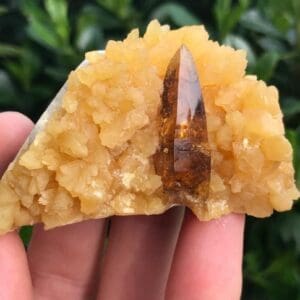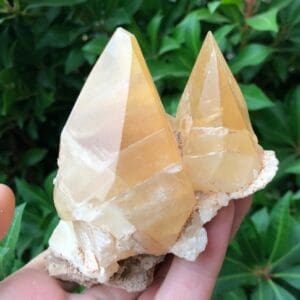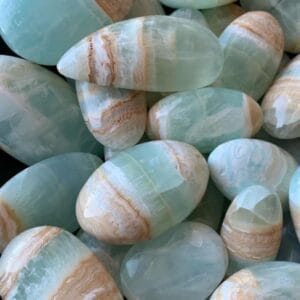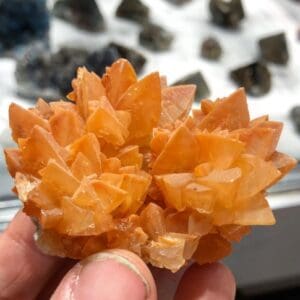Calcite is fairly abundant, easy to source at a local rock and mineral show and it comes in different sizes, shapes, and varieties. Its most common form is in rough form with no crystal faces or edges. It looks like a colored rock you would find at a construction site or in your backyard. These pieces are relatively inexpensive and are used for carving figurines and home furnishings.
The crystal variety is pretty interesting because you can find single crystals the size of your arm all the way down to a small crystal cluster. These are relatively inexpensive and make a great addition to your rock collection. Dog’s tooth Calcite is probably my favorite variety.
If you own a house with marble or limestone then you’re a collector of Calcite and you didn’t even know it because Calcite is a main component of these rocks.
Calcite’s properties make it one of the most widely used minerals on the planet. It is used as an abrasive, construction material, construction aggregates, agricultural soil treatments, pigments, pharmaceuticals, and some. Calcite has more uses than almost any other mineral on Earth.

How Is Calcite Formed?
Calcite can form through the direct precipitation from water rich in calcium. As the concentration of calcium increases and the amount of water decreases, crystals of solid Calcite form.
A large percentage of calcite in rocks was naturally deposited in sedimentary environments. Consequently, Calcite is a component of several diverse sediments, sedimentary rocks, and metamorphosed minerals. An incredibly minor amount of the Earth’s calcite is magmatic in origin; it’s actually the primary constituent of a rare rock specimen called Carbonatite.
Calcite also occurs in veins. While some veins are wholly or largely Calcite, others contain valuable ore minerals, typically described as ore veins, even though Calcite is the predominant mineral.

Green Calcite
Calcite is colorless or white when pure but can be almost any color, including pink, yellow, bluish, greenish, lavender, brown, or black. The colors are caused by the presence of diverse impurities. These stones can be transparent, translucent, or opaque, with a luster that ranges from vitreous to dull. Many crystals, especially those that are colorless, are vitreous, while fine-grained granular masses tend to be dull.
Green Calcite is a translucent, smooth, and waxy stone usually found in massive form. The colors range from yellow-green to bright emerald green. However, some specimens are acid-treated to enhance their natural color.
Green Calcite forms through sedimentation. The crystals or stones offer a glossy or shiny appearance and range from translucent to opaque. Aside from the above colors, the stones can be pale deep to seafoam green, yellowish-green, and white.
Green Calcite is primarily found in Mexico, India, Brazil, and Africa.

Yellow Calcite
Yellow Calcite, along with all Calcite, is composed of calcium carbonate. It belongs to the mineral group carbonates and ranges between 3 to 4 on the Mohs scale. In the stone’s natural form, yellow Calcite can be found in hues ranging from light yellow to orangish-brown.

Blue Calcite
As we mentioned earlier, Calcite is found worldwide in every color. Some more notable deposits of blue Calcite are primarily located in Mexico. However, they can be found in Madagascar and Spain.
Calcite is considered to be a principal crystal and is extracted in commercial limestone mines. It’s mined in shallow pits and the primary deposit where the Calcite remains within the host rock. Once removed, it’s sorted into different grades based on color. The best variety is pure white, at least from a commercial viewpoint. Pure white Calcite can be pulverized into powder and used to make paint, rubber, cement, textile goods, and ceramics. However, collectors and rockhounds prefer the vividly-colored stones mined in small-scale operations.

Orange Calcite Crystal
We’ve saved the best for last. While pale yellowish Calcite is a common mineral worldwide, vibrant orange Calcite is rare. It’s mined and polished in India and China, and the two countries are major trading partners. As a result, the semi-precious stone is more challenging to track along the supply chain.
Calcite’s metaphysical traditions aren’t very old. In fact, the energies of specific colors, such as orange calcite, were initially described in the 21st century. However, the mineral and stones are much older and have been used for many years.
Calcite Pronunciation
Kal-Site or kal-syt.
What Is The Hardness of Calcite?
Calcite measures about a 3 on the Mohs hardness scale. This means it can be scratched easily with a geological pick or knife blade. The stone’s specific gravity is 2.71.
Three perfect cleavages provide Calcite with six-sided polyhedrons with diamond-shaped faces. The angles defining Calcite’s faces are 78 and 102 degrees. Calcite has three important crystal habits or distinctive mineral shapes: prismatic (short and long), rhombohedral, and scalenohedral. Twinning is incredibly common and can be of secondary origin in crystalline limestone samples.
Calcite is widely harvested, utilized, and collected. It comes in an array of colors and is readily available worldwide, but that doesn’t mean it has no value. Smaller specimens can bring in a few bucks and up but typically don’t value more than $15. Larger samples are where the money is at. High-quality specimens can fetch hundreds to thousands of dollars.
- Identify Enstatite - March 12, 2024
- Identify Cerussite - March 3, 2024
- Identify Bytownite - February 18, 2024
